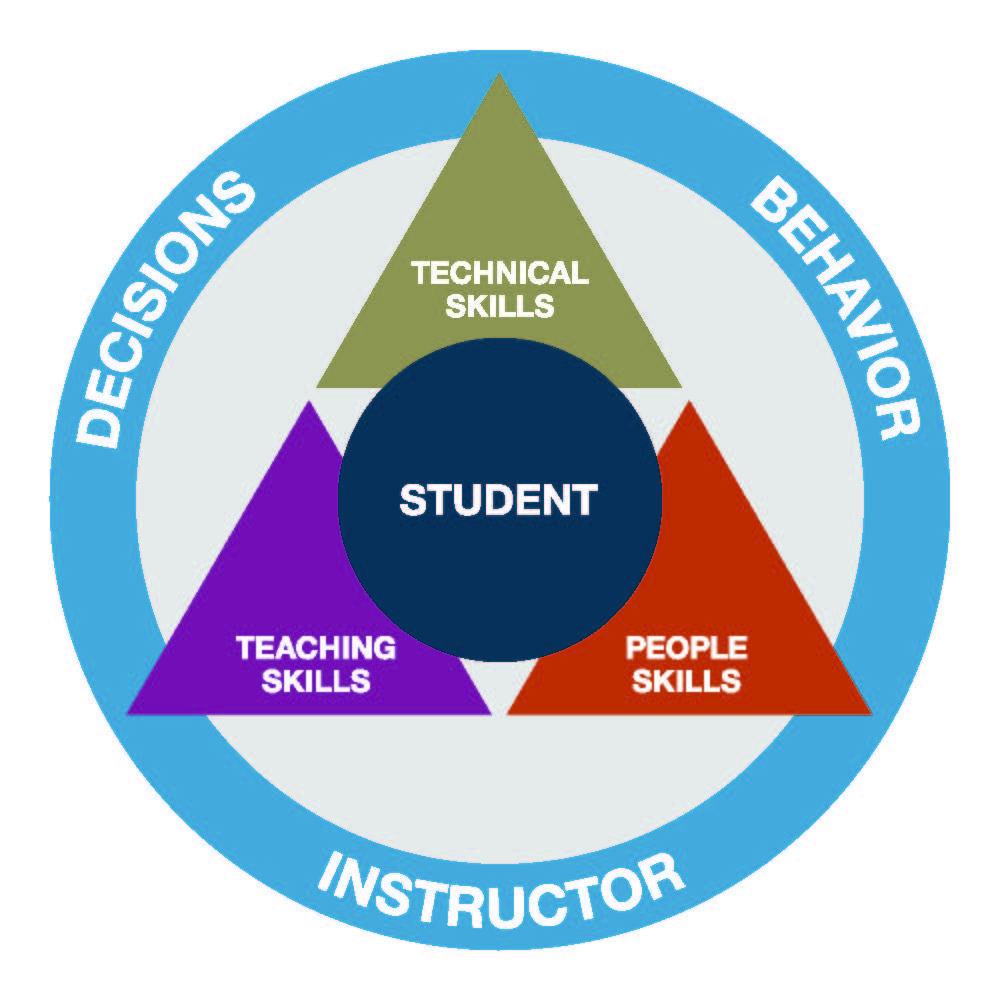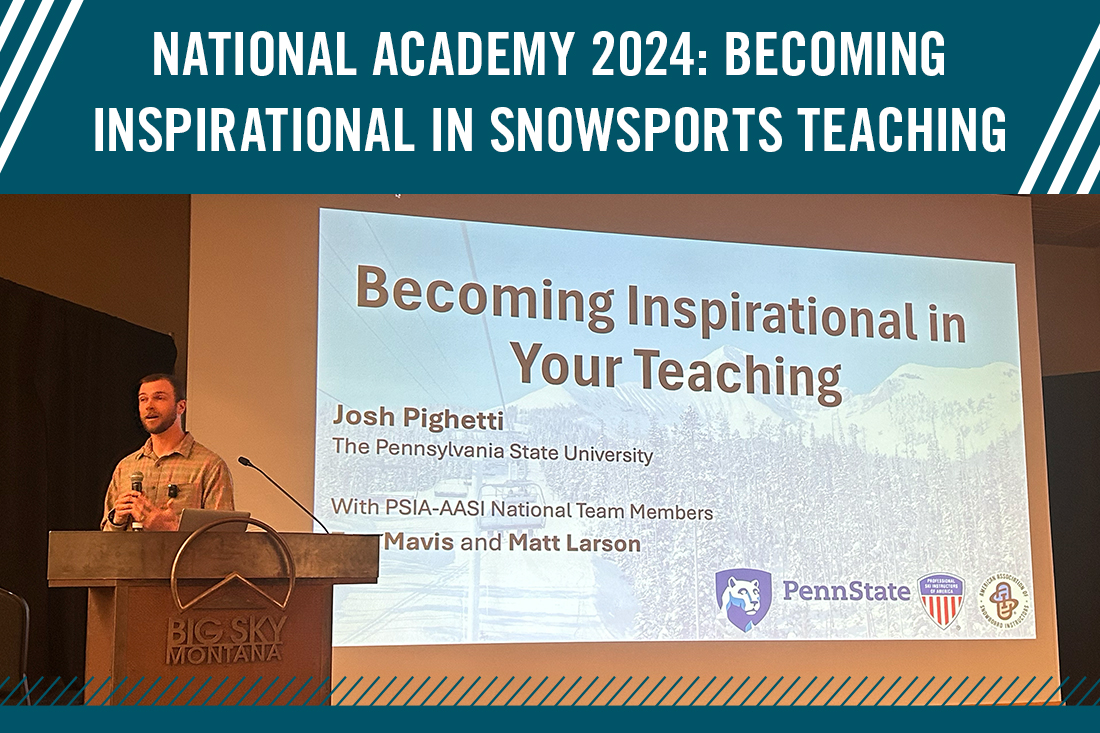National Academy 2024: Becoming Inspirational in Snowsports Teaching
PSIA-AASI’s largest national event of the year kicked off Monday, April 15, at Montana’s Big Sky Resort. The annual, weeklong gathering provides an opportunity for instructors from all levels, all disciplines, and all parts of the country to gather for on- and off-snow education, inspiration, and networking.
Opening night was headlined by Josh Pighetti, a Ph.D. candidate at Penn State University focusing his research on snowsports education. Josh is a Level III alpine, Level I snowboard, and Level I adaptive instructor who does most of his teaching at Disabled Sports Eastern Sierra in Mammoth, California. He has also been instrumental behind the scenes working on PSIA-AASI Performance Guides and Standards.
Josh’s research on inspiration in snowsports education is intended to help all of us bring inspiration to all skiers and riders. His presentation was based on observing clinics led by PSIA-AASI National Team members; interviews with participants learning from team members; and interviews with the team members about what they do, how they do it, and how they develop those skills.
Josh was also joined by PSIA-AASI National Team members Zoe Mavis and Matt Larson, who offered real-world insights and applications of some of Josh’s research. But we don’t just need the members of the national team to be inspirational; we need all 34,000 members of our organization to be inspirational.
Here is what we learned:
Why Does Inspiration Matter?
Inspiration matters because instructors are influential in the ski and snowboard industry and are ambassadors to the whole of American snowsports.
Instructors interact with most skiers and riders on their mountains – whether they are students or not – and demonstrate what good, enjoyable snowsports looks like. Because of this, instructors have a unique opportunity to do more than just teach ski and ride skills. Instructors are creating lifelong passion for students by giving them autonomy, competence, and a sense of belonging. Instructors are also on the front lines of welcoming newcomers to these sports.
What Is “Inspiration?”
Inspiration is something that triggers the desire to strive for and achieve a new potential. Inspiration also ignites passion, helps people discover possibilities for themselves, and, critically, catalyzes the kind of motivation that leads to action. Inspiration engenders the desire to try something new, improve, grow, or advance; to do more, learn more, and be more.
How can snowsports instructors inspire? Consider these tips based on the Learning Connection Model:

1) People Skills
- Genuine engagement and connection are step one in inspiring.
- Engage through recognition. Learn about your students’ goals, needs, interests, and previous experiences. Hold on to that knowledge and continually return to it throughout the clinic or lesson.
- Connect on an empathetic level. The instructor should “join” the student in the process, as in, “Hey, I’ve been there; I understand your struggle. Here are some tools to help you progress.”
- Be humble. Be human. Go to the students’ level. Despite the teacher-student hierarchy, maintain a peer-to-peer connection.
2) Purposeful Teaching
- Remember to experiment, explore, and play.
- Help students understand what moves work and why, and how to translate those moves across different terrain and condition types.
- Don’t forget play! Sometimes you can’t let learning get in the way of fun.
- Feedback must happen, and feedback doesn’t have to be verbal. Feedback can be the instructor moving a student toward autonomy and competence by teaching them to understand what the mountain is saying to them through their equipment.
3) Technical Mastery
- Demonstrate outstanding performance, though this is not just about advanced moves. Instructors must be able to demonstrate, at an elite level, even the most basic moves so the student can see what’s possible.
- Create potential for improvement. Develop your “expert eye” to be able to do high-level movement analysis in the moment.
- Distill knowledge. Don’t throw the book at a student.
- Use analogies to bring familiarity to a new concept.
- Create cues or keywords with your students to have a shared language. This should relate back to the students’ goals, background, and experience.
Josh also shared his thoughts on how his research into inspirational snowsports teaching has impacted his own work on the snow: “When I started the season after interviewing 27 people about inspiration, I forgot what my skills were . . . As I went through the season, I found what was authentic to me. A lot of that came down to teaching a bit more slowly and having more collaboration with the students . . . Sometimes learning through the whole day is not the purpose. There is a bit of the experience that is social, too. There is something to learning about the place – why is it special to me and to others?”
Watch Josh’s general session.
You can learn even more about inspirational teaching in the Spring 2024 issue of 32 Degrees, available free to members, and on our website.
We also invite you to learn more about the Undergraduate Certificate in Professional Snowsports Education at Penn State University. The program was launched in January 2024 following nearly seven years of collaboration with PSIA-AASI.







